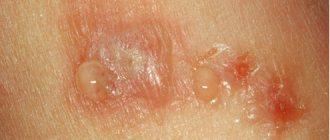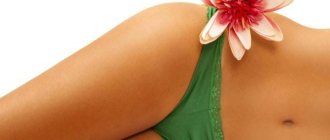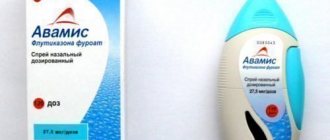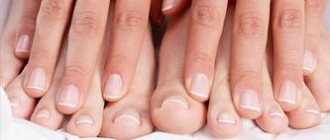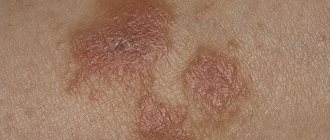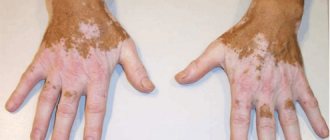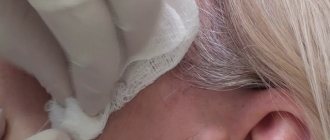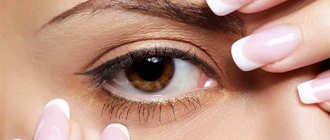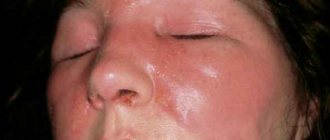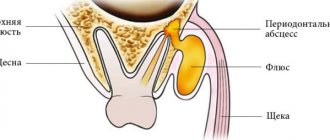Hello dear readers. In today’s article we will understand what oral dermatitis is in a child.
What symptoms does it accompany, what can cause this disease, and what methods will a specialist treat the disease with?
Parents will immediately see signs of oral (perioral) dermatitis in a child, although, most likely, they will not determine what type of rash appears, because there are quite a few types of dermatitis in children.
The very name of the disease (the concept “oral”) indicates that skin irritation appears around the mouth and can spread to the skin near the nose, under the eyes, and on the eyelids.
The disease is not one that often appears in children; it usually does not cause any particular discomfort to the child. Parents are more concerned about the appearance of the baby.
What is the disease?
A disease such as perioral dermatitis has a code in ICD-10 of L71.0. This pathology has a second name in medical circles - perioral or rosacea-like dermatitis. It occurs quite rarely and most often affects women between the ages of 20 and 40. Oddly enough, the disease more often affects the skin of women who carefully care for themselves.
Perioral dermatitis is manifested by the appearance of small pimples, redness and papules on the skin around the mouth. The spots begin to peel off and spoil the appearance, which causes considerable physical and psychological discomfort. Over time, they become more numerous and occupy almost the entire chin. After healing, dark spots remain in place.
What can trigger the appearance of pathology?
Why does the disease appear?
The area around the mouth on the face, which includes the chin and perioral skin, is called the perioral region.
The skin in this area is very often exposed to all sorts of irritations, resulting in acne or rashes. Such phenomena usually cause severe psychological discomfort, especially when it comes to young women.
oral dermatitis in the photo
This disease is very difficult to miss. More precisely, it is even impossible not to notice it. Perioral dermatitis is a skin rash in the form of small pinpoint pimples located around the mouth. It all starts with the most common irritation. The skin around the mouth becomes red.
After some time, small red dots appear, which later develop into full-fledged pimples. In turn, the pimples begin to grow and merge with each other, the skin peels off and, in most cases, pustules begin to form.
Dermatitis is a whole complex of symptoms that appear in a person in response to any irritant. There are two types of dermatitis: contact form and toxicoderma.
The first manifests itself in adults and children as a reaction to exposure of the skin to any harmful substances, while toxicerma is caused by internal effects.
Treatment for dermatitis depends on the type of disease and its stage. A variety of allergens can cause a skin reaction in humans: foods, certain types of plants and animals, chemicals, burns, etc.
Skin dermatitis is divided into several types, depending on the cause of the disease.
The following types of disease are distinguished:
- seborrheic dermatitis. It appears due to improper functioning of the sebaceous glands, which produces too much sebum. Symptoms of this form of the disease are acne and pimples, as well as dandruff if the scalp is affected;
- contact dermatitis. It is always caused by an external factor. Its main symptoms are redness or allergic rashes that appear at the site of contact with the allergen;
- allergic skin dermatitis. It is also caused by an allergen, but internal and not external. This type of disease usually does not appear immediately, but 7–14 days after the first contact;
- atopic dermatitis. This form of the disease is considered the most complex because it is hereditary.
Regardless of the form of the disease, dermatitis always has three stages of development: acute, subacute and chronic.
Treatment of the third stage in adults and children is the most complex and requires complex therapy: in addition to medication, the patient will also need a special cream, diet and other means.
Additional treatment of various forms of the disease can also be effective with folk remedies, for example, herbal decoctions.
Dermatitis on the face and other parts of the body has a wide variety of causes; both external and internal factors can affect the development of the disease in adults and children.
In some cases, the disease may be genetic in nature, but acquired dermatitis caused by various factors is much more common.
Dermatitis most often occurs in adults with weakened immune systems. Disturbances can be caused by previous illnesses, infections, general weakness of the body, stress and living in unfavorable conditions.
In this case, the immune system becomes less stable and is more easily susceptible to the harmful effects of allergens.
This is especially true for chronic dermatitis: in this case, the disease will return under unfavorable conditions, regardless of the treatment.
Causes of perioral dermatitis
The manifestations of the disease can be pronounced and intense, appearing in a short period of time, but there are cases when the pathology develops over a long period of time and without characteristic symptoms. You should be wary and visit a doctor if:
- A rash appeared, located in clusters.
- The chin and skin around the mouth itches and a burning sensation occurs.
- Feeling of tightness of the skin around the mouth, dryness and flaking.
- Pimples with purulent or watery contents.
Perioral dermatitis on the face can appear periodically, heal within a couple of months, and then return again. As a rule, doctors associate the first manifestations of pathology with several causes, although the exact etiology of the disease is still not known:
- Disturbed hormonal levels.
- Gynecological problems.
- Incorrectly selected cosmetic products.
- Using expired cosmetics.
- Toothpaste or chewing gum with fluoride.
- Exposure to ultraviolet rays.
- Perioral dermatitis often occurs against the background of increased sensitivity to steroid and hormonal drugs.
- Disturbances in the functioning of the gastrointestinal tract.
- Decreased protective functions of the body.
- Applying a large amount of cosmetics, especially low quality, to the face.
- Rashes can be caused by fungi and bacteria that have settled in the hair.
Recently, cases of diagnosing the disease in men have become more frequent. This can be explained by the fact that a strong half of humanity also uses cosmetic skin care products.
Symptoms
This form of dermatitis is accompanied by the following symptoms:
- the appearance of itching, hyperemia, pain and burning in the mouth and chin (pictured);
- small pimples may have a head, upon opening of which, in the initial stage, a separation of transparent exudate is observed. In the future, it can develop into purulent;
- rashes can group together, forming colonies.
Rosacea-like dermatitis is accompanied by the appearance of scales on the inflamed areas, which may subsequently fall off on their own. This manifestation of the disease occurs quite often with this type of dermatitis.
With this disease, small pockets of inflammation, similar to pimples, begin to appear on a person’s chin and in the area around the mouth, and redness and irritation of the skin occurs. The following signs are considered characteristic of oral dermatitis:
When should you visit a doctor?
If you are concerned about perioral dermatitis and have taken some home measures, you will have to go to a dermatologist in the following cases:
- When all cosmetics are discontinued, no improvement is observed.
- If you need to do something about the disease, but you can’t stop using cosmetics.
- There is an urgent need to improve the condition of the skin.
- There is severe peeling on the skin and a lot of pimples with purulent contents.
After examination and conversation with the patient, the doctor prescribes treatment.
Diagnostics
After the first signs appear, you need to consult a dermatologist. The diagnosis is made on the basis of the clinical picture characteristic of the pathology and dermatoscopy.
Laboratory methods:
- clinical blood and urine tests;
- blood chemistry;
- Demodex detection test;
- bacterial culture of the contents of rashes or skin scrapings (determination of flora);
- bacteriological study of intestinal flora.
Skin biopsy and serological tests may be needed for differential diagnosis. The disease must be distinguished from allergic contact dermatitis, rosacea and vulgaris, impetigo, seborrheic dermatitis, and neurodermatitis.
For certain indications, consultations with specialists may be necessary: endocrinologist, gynecologist, psychoneurologist, gastroenterologist.
Recommendations for self-relief from perioral dermatitis
Many dermatologists tend to believe that following simple recommendations can help get rid of pathology:
- If your toothpaste contains fluoride, try replacing it with regular toothpaste.
- Avoid any cosmetic products in facial skin care.
- Stop using ointments and creams with glucocorticoids.
- If you need to use inhalers with glucocorticoid hormones, you should discuss the issue of replacement with your doctor.
These recommendations imply the exclusion of drugs that can provoke the development of pathology. It should be taken into account that when glucocorticoid drugs are discontinued, the skin condition may worsen, but after a couple of weeks a noticeable improvement will be observed.
Adviсe
The duration of therapy depends on many factors - the degree of manifestation of dermatitis, the duration of pregnancy, and the state of the patient’s immune system. For a speedy recovery, first of all, you should stop using any cosmetics, stop using skincare and external medications, and work with your doctor on a proper facial care routine.
An important condition for treatment is complete avoidance of direct sunlight and the use of sunscreen even in the shade. A pregnant woman should completely avoid using any corticosteroids. Vitamin therapy and dietary nutrition will also help in treatment.
If all recommendations are followed, improvement will be observed within a few days. To prevent dermatitis, the expectant mother needs to monitor the general health of her body and try to avoid any stressful situations.
Treatment of the disease
If stopping cosmetics and medications does not help, then you need to visit a doctor. Since the disease can be provoked by the presence of internal problems in the body, consultation with other specialists is often required: gynecologist, endocrinologist, neurologist, therapist.
Therapy after examination is carried out in several directions:
- Taking antibacterial agents.
- Use of ointments and creams.
- The use of folk remedies.
- Nutrition correction.
Let's look at all types of treatment in more detail.
Diet for allergic dermatitis
Allergic dermatitis develops if a person eats foods that the body cannot tolerate. Food allergens that cause dermatitis should be excluded from the patient’s menu.
Allergies are often triggered by orange-red fruits and berries, milk protein, peanuts, cocoa, bee products, etc. Fried, salty, fatty and spicy foods can provoke the disease.
Food should be prepared from fresh ingredients. Vegetables and fruits are kept in water (usually overnight). This method allows you to remove allergy-causing substances from the fruit.
Minimize the consumption of sweet and salty foods.
Treatment with antibiotics
If zero therapy does not lead to noticeable results, then doctors are inclined to prescribe antibiotics. These drugs can cure the patient of the disease. Most often prescribed:
- "Minocycline" tablets.
- "Doxycycline."
- Metronidazole tablets or cream for perioral dermatitis with Metronidazole.
The effect of taking antibiotics can be noticed after 2-3 weeks, but you should not stop the course of therapy ahead of time; the duration of treatment is determined by the attending physician. During treatment with antibiotics, it is necessary to take medications to maintain intestinal microflora.
The treatment regimen may look like this:
- Take Doxycycline or Minocycline 2 times a day in the dosage prescribed by the doctor until the skin rash disappears. Then the dose of the medicine is reduced, and administration continues for another 4 weeks.
- Metrogyl gel, which must be applied in the evening, will help relieve the symptoms of perioral dermatitis.
This scheme will give noticeable improvements in a short time.
First symptoms and signs
The first sign by which one can judge the appearance of perioral dermatitis is slight redness of the face. It becomes more pronounced when eating spicy and hot foods.
After some time, it acquires a brighter shade, and the skin becomes covered with small pustules 0.4-2.5 mm, similar to acne. Over time, they turn into crusts and peel off.
During the course of the disease, the color of the rash changes from red-brown to light brown.
The localization of the rash is more or less symmetrical on the chin, nasolabial folds, nearby areas of the lips, cheeks, and does not merge together. Single rashes may be observed on the temples and bridge of the nose.
Diffuse inflammation of the entire face occurs. A specific feature of the disease is a whitish stripe between the labial border and the area of inflammation.
Ointments for the treatment of perioral dermatitis
In addition to taking antibiotic tablets, your doctor will prescribe ointments to treat perioral dermatitis. It is recommended to use only those drugs prescribed by a specialist. It is prohibited to use products based on hormonal components.
If you have a diagnosis such as perioral dermatitis, treatment with ointments will speed up the healing process. The following compositions are allowed for use:
- "Metronidazole", "Trichopol". These ointments, despite their low cost, are quite effective. Apply the ointment to clean skin in the morning and evening. The duration of treatment depends on the severity of the condition and is determined only by the attending physician. Usually it takes about 3-9 weeks.
- Erythromycin ointment will also help overcome the diagnosis of perioral dermatitis. In dermatology, this remedy is used often and quite successfully. The product copes with redness and accelerates tissue restoration.
- Zinc ointment for perioral dermatitis eliminates inflammation, reduces swelling, itching and redness. The low risk of side effects allows the product to be used even in the treatment of pregnant women and children. The ointment is applied 1 to 3 times a day, depending on the severity of the pathology. The duration of therapy is 5-10 days, but in severe cases it can be extended up to a month.
- The following ointments have shown good results in the treatment of perioral dermatitis: “Bepanten”, “Skinoren”.
When using all of the medications listed, we must not forget about side effects, so only a doctor should prescribe medications. Treatment under the strict supervision of a specialist will be much more successful.
Therapy can be completed with physiotherapeutic procedures. The most suitable for this case:
- Use of liquid nitrogen. It removes formations on the skin well.
- Laser therapy. Relieves puffiness, reduces inflammation, accelerates tissue regeneration, increases blood flow to the upper layers of the skin. In a short time, the skin takes on a healthy appearance.
- Radiation may be needed if the skin is severely affected and involves a large area.
Such an integrated approach will speed up recovery and eliminate relapse of the pathology.
Antihistamines for oral dermatitis
Parlazin
The drug Parlazin
The drug is available in the form of tablets and drops; for adult patients, it is preferable to use the solid form of the active substance. To relieve symptoms of oral dermatitis, you need to take 10 mg of the active ingredient, which is equal to one tablet. The effectiveness of Parlazin does not depend on food intake, which allows you to take it at any time. The only recommendation for taking these antihistamines is that it is better to take the prescribed dose in the evening an hour before bedtime. For better absorption, the tablet should be taken with 0.2 liters of still water.
Suprastin
Traditional antiallergic drug Suprastin
A traditional antiallergic drug used to suppress most types of allergies and dermatitis. Suprastin can be used in childhood and adulthood with correctly selected doses of the main substance. When treating adult patients, it is recommended to take one tablet of the drug up to 4 times a day. For mild degrees of oral dermatitis, taking 2-3 tablets of the medication is sufficient.
Zyrtec
Zyrtec has minimal negative effects on the body
A modern antihistamine that has minimal negative effects on the patient’s body. You can take the drug in the form of drops and tablets. Like Parlazin, Zyrtec is prescribed to adult patients in solid form. To treat the described disease, in the first two days it is recommended to take 5 mg of the active ingredient, which is equal to half a tablet or 10 drops. If after 48 hours the intensity of symptoms does not decrease, the dose must be doubled to 10 mg or 20 drops. The drug is taken without taking into account food intake daily.
Attention! Only the attending physician can select the exact course of taking antihistamines for each patient. Its duration is influenced by the severity of symptoms of oral dermatitis, the presence of complications, age and previous medical history. Typically, medications of this type are taken for at least one week.
Taking care of your skin during treatment
During treatment for perioral dermatitis, it is important to follow the following skin care recommendations:
- Do not use cosmetics that were used before the onset of the disease. Use only products prescribed by your doctor.
- After eliminating all manifestations of the pathology, gradually return to the usual care creams, lotions and masks, but do this with the permission of the attending physician.
- To improve the condition of the skin, it is advisable to use a complex containing vitamin B and nicotinic acid. This will not only speed up skin regeneration, but also strengthen the immune system.
ethnoscience
To speed up the process of treating dermatitis, it is useful to use decoctions and infusions of medicinal herbs that have already proven their effectiveness:
- chamomile.
- sage.
- linden blossom, etc.
Natural vegetable oils (grape seed, peach, argan, etc.), which are recommended to lubricate problem areas of the skin, are no less effective against this disease. It is important to remember that any disease is easier to cure if you seek medical help in a timely manner.
Perioral dermatitis in children
In children, this disease occurs much less frequently than in adults, but occurs with more severe symptoms. Doctors often have to treat advanced forms of the disease because parents confuse it with contact dermatitis due to drool during teething, or with a common allergy to certain foods.
The first symptoms of this form of dermatitis may appear during meals and then disappear. As the disease progresses, the rashes become persistent. At the first suspicion of pathology, you should urgently visit a dermatologist. The sooner therapy begins, the more successful it will be.
If a diagnosis of oral dermatitis is made, treatment in children is reduced to taking the following medications:
- Antibiotics from the tetracycline series. But it must be remembered that these drugs are prohibited for use in children under 8 years of age.
- Zinc ointment. A reliable and proven remedy for treating many skin problems. Effectively relieves inflammation, reduces itching and redness. It is allowed to use the product even in the treatment of newborns. The non-toxicity of the product prevents overdose even with frequent use.
- Antihistamines help eliminate itching and relieve redness, but due to the risk of side effects, they should be taken only after consulting a doctor.
The presence of perioral dermatitis in a child requires gentle skin care. It is not recommended to rub your face too much after washing; just blot with a napkin. If oral dermatitis is diagnosed, treatment in children involves excluding the following factors:
- Toothpastes containing fluoride. It is better to choose a more suitable dental care product for your child.
- Use of ointments and gels with hormones.
- Uncertified children's cosmetics.
Often it is enough to remove negative factors and no treatment is required. Mothers can be advised not to start self-medication if they discover skin problems in their baby, but to visit a specialist.
Therapeutic techniques
The specialist will diagnose the oral form of childhood dermatitis and prescribe treatment. Therapy is usually complex.
It should be noted that treatment of the disease is quite long-term and may include the following measures:
- Prescribing a hypoallergenic diet is mandatory for oral dermatitis. Plant-based foods are preferable. Meat or fish should be steamed. Chips, sweet carbonated drinks, and any sweets with flavors or dyes are not allowed. In general, you need to eat less sweets, as well as flour. The doctor will tell parents more about the composition of the diet, based on the individual characteristics of the child and his condition. But he will definitely recommend introducing oatmeal into a child’s diet: its benefits for the skin have long been proven by nutritional scientists.
- Taking antihistamines to reduce the allergic mood of the children's immune system (doctors prescribe children, as a rule, antihistamines of the third newest generation, which do not cause side effects).
- Using antiseptics to treat sore skin.
- Frequently wash your child without wiping his face with a towel.
- Avoiding walking in direct sun.
- The use of anti-inflammatory creams, gels, ointments. The specialist often prescribes medications based on Metronidazole or Erythromycin, which have a broad spectrum of action.
- Taking vitamin complexes containing ascorutin, nicotinic acid, and a number of other vitamins that have a beneficial effect on the skin.
- Use of antibiotics (ointments for babies, tablets for older children).
- The use of traditional medicine (decoctions of calendula, chamomile, aloe, sage, St. John's wort, celandine, birch buds for lotions).
The doctor never treats oral dermatitis in children with hormonal medications.
All drugs (and herbs used in traditional medicine recipes, too) are prescribed only by a specialist. Before prescribing medications, the specialist will always make sure that the child is not allergic to them.
If oral dermatitis has affected the skin around the eyes, a visit to an ophthalmologist is necessary to avoid the negative impact of the disease on children's vision.
A child can recover only if the parents strictly follow all the doctor’s instructions.
Then the treatment will be effective, oral dermatitis will not become chronic, and the child’s skin will become clear.
Folk remedies in the treatment of perioral dermatitis
In the presence of perioral dermatitis, treatment with folk remedies can complement the main therapy. Traditional healers recommend the following recipes to get rid of the disease:
- Make lotions on the affected areas of the skin from the infusion of string, celandine, and plantain.
- Flaxseed oil compress. Mix flax oil and honey in equal proportions, heat in a water bath and add a little onion juice. Moisten a napkin in the mixture and apply to the skin.
- A pumpkin mask gives good results. Grate the pulp and apply to the affected areas on the face.
- Decoction of birch buds.
- Infusion of oak bark.
- You can use aloe or Kalanchoe juice to treat the skin.
- Beekeeping products have a bactericidal effect, so they will also help get rid of the manifestations of perioral dermatitis.
- Propolis-based ointment. Take part of the propolis and combine with 4 parts of vegetable oil, heat in a water bath until it is completely dissolved.
- Dissolve a teaspoon of baking soda in a glass of water and wipe the skin.
When choosing folk remedies, you must remember that the effect of their use will be if they are used in combination with drug therapy.
Giving help
Oral dermatitis should be treated comprehensively. The goal of therapy is to eliminate factors that provoke the disease, relieve inflammation, and prevent the development of pathogenic flora and its spread. An important role is played by reducing sensitivity and proper facial skin care. Additionally, they use folk remedies made from natural ingredients that can be prepared at home.
Medicines
At the first stage, the patient must stop using hormonal ointments and creams, as well as the use of cosmetics.
This is especially true for powder, foundation and other products that affect the area of rashes. Already at this stage, a significant improvement in the condition may occur.
Treatment with topical medications usually includes:
- Local remedies with metronidazole (Trichopol). The ointment is applied twice a day. More effective is a 2% gel with the same active substance.
- Preparations containing erythromycin. It belongs to the macrolide family and is a broad-spectrum antibiotic with a bacteriostatic effect. The use of Erythromycin ointment is relatively safe and helps very well with this problem. The price is low and affordable for every patient.
- Protopic is recommended for facial skin care. Milk helps relieve inflammation and is non-toxic. Used in adult patients and adolescents over 16 years of age (0.01%). For children over 2 years old there is Protopic 0.03%. Not indicated for use in women during pregnancy and breastfeeding.
- For various inflammatory conditions on the skin, Adapalene cream is used. Its action relieves inflammation, eliminates and protects against the formation of comedones. In addition, the product allows you to accelerate the restoration of normal epidermis. For oily skin there is Adapalene gel.
- Elidel. It can be used by children from 3 months of age. In 1-1.5 months, the product allows you to completely eliminate the pathological process.
- If a patient develops perioral dermatitis while using glycosides, then in addition to discontinuing these medications, Rosamet cream helps. It is a very strong drug, but it acts mainly at the local level, almost without penetrating into the blood. With this treatment, it is not recommended for the patient to stay in direct sunlight. The product is applied very carefully. Do not allow it to get into your eyes. Since Rozamet does not leave a greasy residue, it can be used as a base for foundation.
Systemic drugs
If you have festering acne, doctors recommend taking antibiotics that have a broad spectrum of action.
Most often, Doxycycline is used for this purpose, which must be taken 100 mg twice a day for a week. Severe dermatitis usually resolves faster if exposure to pathogenic microorganisms is actively controlled. Not used during pregnancy, in children under 12 years of age, or in cases of impaired renal or liver function.
To relieve the allergic component, antihistamines in tablets are additionally used - Loratadine or Suprastin.
Folk remedies
In addition to pharmaceutical preparations for topical use, you can prepare and use drugs according to the advice of traditional healers. They will allow you to quickly get rid of the problem and prevent possible complications.
- An infusion of birch buds is used to wipe inflamed skin. Take a glass of boiling water for one large spoon of raw material. The broth should sit for an hour (it is better to wrap it first). After filtering, you need to wipe your face with the product, and then apply a medicinal ointment.
- One tablespoon of chamomile and calendula flowers should be poured into 500 ml of boiling water. Leave for 1 hour and strain. Moisten clean gauze with the cool infusion and apply for 20 minutes. The procedure can be repeated several times a day.
- Take the herb (4 large spoons) and keep it in a water bath in 0.5 liters of boiling water for an hour. After this, the broth should be left for another hour and filtered. Soak a gauze pad or cotton pad in the cooled product and apply it to the skin until warm. After this, the lotion should be replaced with a fresh one.
- You can use propolis ointment. For one part of propolis you need to take 4 parts of purified vegetable oil. Place everything in a special container and heat in the oven until the propolis is completely dissolved. After this, the product is thoroughly mixed and allowed to cool. The medicine is applied to the affected areas several times a day.
- To prepare the rub, you need to combine aloe juice with the same amount of honey and medical alcohol. The mixture should be used twice a day before applying the ointment.
Before starting treatment, you should consult your doctor.
Reconsidering nutrition
If you have skin problems, you won’t be able to improve the situation without adjusting your diet. Any form of dermatitis is no exception. A diet for perioral dermatitis involves excluding from the diet such foods as:
- Any products that can provoke an allergic reaction.
- Fatty and fried foods.
- Spicy seasonings, marinades.
- Exotic fruits.
- Milk.
- Sweets.
- Limit consumption of fish and mushrooms.
- Reduce the amount of salt in your diet.
- Alcoholic drinks must be prohibited.
- It is forbidden to eat fast food.
You need to eat regularly, including dishes and foods rich in fiber.
Diet for atopic dermatitis
Since atopic dermatitis is an allergic disease, when it occurs, it is important to adhere to a hypoallergenic diet. This will not only help speed up recovery, but also prolong remission in chronic cases. To identify “dangerous” foods, patients are asked to keep a food diary. Additional general recommendations include:
- limiting salt and sugar,
- giving up alcohol and smoking,
- fractional meals in small portions,
- limiting red fruits and vegetables, consuming them only after heat treatment,
- plenty of drinking regime (up to two liters of water per day),
- a diet with a sufficient amount of vitamins and microelements or taking them in the form of vitamin complexes in tablet form (according to indications and doctor’s prescription).
It is important to use a food diary and allergy tests to identify allergens that provoke exacerbations of atopic dermatitis in order to completely eliminate them from your diet.
Protecting yourself from sun rays
During treatment of perioral dermatitis, it is necessary to avoid direct exposure to sunlight and temperature changes. It is important to adhere to the following recommendations:
- It is impossible to lock yourself in a dark room during treatment, so when going outside, especially in the summer, protect your face from sunlight.
- Use sunscreens, but their selection should be done by a doctor so as not to worsen the situation.
- The temperature in the room should be normal; too high will lead to a decrease in the positive dynamics in therapy.
Following all the doctor’s recommendations and taking prescribed medications will help you get rid of the symptoms of the disease faster.
Treatment with ointments
According to reviews, treatment of perioral dermatitis with folk remedies is most effective only with an integrated approach. In other words, it is recommended to treat the affected areas of the skin with homemade ointments.
The most effective recipes:
- Grind 20 g of propolis. Mix it with unrefined olive oil (80 ml). Place the container with the product in a water bath. Simmer the mixture until it reaches a homogeneous consistency. Cool. Treat pathologically altered areas of the skin with the prepared ointment. It is important to know that propolis contains caffeic acid, which is an allergen. If signs of an undesirable reaction occur, treatment of perioral dermatitis with a folk remedy should be stopped.
- Birch tar has proven itself well in relation to the disease. An ointment based on it has powerful anti-inflammatory, antimicrobial and anesthetic properties. Method for preparing a healing remedy: take 20 g of tar, 15 g of honey, 15 ml of castor oil and the white of one chicken egg. Mix all ingredients thoroughly in a glass container. Place it in a dark place. Let the product brew for 3 days. Treat foci of pathology with the prepared ointment twice a day.
- A highly effective folk remedy for treating perioral dermatitis is sulfur. The mash based on it has good antiseptic and anti-inflammatory properties. To prepare the product, you need to take 7 g of purified sulfur powder, 7 g of Streptocide, solutions of boric and salicylic acid (50 ml of each). Mix the ingredients in a dark glass container. Apply the resulting product to the affected areas three times a day. It is important to know that sulfur dries out the skin. After using the mash, apply moisturizer to your face.
We must also remember that any medicinal product is a potential allergen. If alarming signs occur, treatment with traditional methods should be stopped.
According to reviews, within a few days after using self-prepared ointments, the rashes fade or disappear altogether, the inflammatory process stops, and itching and burning subsides.
Prevention of dermatitis
If perioral dermatitis has been cured, this does not mean that the disease will not return again. To reduce the risk, it is necessary to take preventive measures:
- Avoid using ointments and cosmetics containing corticosteroids if possible.
- If there is no such recommendation from the dentist, then it is better not to use toothpastes with fluoride. Be especially careful when choosing toothpastes for children.
- Carefully select personal hygiene products for washing clothes and washing dishes.
- Lead a healthy lifestyle.
- Follow your doctor's dietary recommendations.
- Do not consume foods that are harmful to health.
- Observe personal hygiene rules.
- If there are infectious diseases, treat them promptly.
- Monitor the functioning of the gastrointestinal tract.
- If the doctor recommends, then periodically take fortifying and vitamin preparations.
- Monitor the state of the nervous system.
Any skin problems are most often the result of a disruption in the functioning of internal systems and organs in the body. You should not self-medicate or listen to the advice of friends and neighbors. Those remedies that helped one person are not guaranteed to be effective in treating another. Yes, and problems can be different, provoked by various reasons.
Independent elimination of the symptoms of perioral dermatitis is fraught with the development of even greater complications. The manifestations may only become brighter, or after such self-therapy there will be scars and marks on the skin.
Possible consequences
Due to the fact that this form of dermatitis is quite resistant to treatment, as a result the patient may develop irritability, become depressed, nervous, and depressed.
Aesthetically, the face does not look attractive. This is a chronic disease, and each subsequent relapse may have more severe symptoms.
After improper treatment, the face remains with scars and age spots. Areas of skin affected by dermatitis become dry and pale. But in most cases, the prognosis for treatment is favorable, without serious consequences.
There is a separate article on our website about how to treat toenail fungus. All about the reasons for the appearance of moles on the body is at this address.
Diet for contact dermatitis
Rashes appear as a result of exposure to chemicals and metals on human skin. Most often occurs in those people who are susceptible to allergic reactions from birth. Occurs on the hands or on any other part of the body.
The diet for this disease is responsible for the main goals:
- saturate the human body with useful substances that are lacking during the inflammatory process,
- stop eating allergens.
During the examination, products that have ever caused an allergic reaction in this particular person are completely excluded. Even permitted products must be thoroughly cooked.
Reduce food intake:
- baked goods,
- White bread,
- beef meat,
- apples (fresh and baked),
- high fat sour cream,
- vegetable stew.
Restrictions are necessary in order not to overload the digestive system and not cause swelling. In this state, the body is able to effectively fight toxins.
With contact dermatitis in adults, when the amount of food consumed is reduced, vitamin deficiency may occur. Therefore, the patient is prescribed complexes of vitamins and minerals.
Treatment of this disease involves large amounts of fluid intake. A person should drink 2–2.5 liters of water per day. You can use fresh or dried fruit compote, without sugar. This is necessary to remove toxic substances from the body.
To restore the body's functioning, the following vitamins are required:
- vitamin C, participates in the process of hormone synthesis, thereby reducing inflammation,
- vitamin E, helps improve lymphocyte functions,
- Vitamin A promotes tissue repair.
Due to a sufficient amount of vitamins, toxins are eliminated from the body much faster.
Diet for dermatitis on the hands
A diet for hand dermatitis should be designed taking into account the characteristics of a particular organism. The presence of individual hypersensitivity, impaired permeability of intestinal walls and other factors that cause the appearance of dermatitis are taken into account.
If you have dermatitis on your hands, you should eat a balanced diet, taking into account a person’s daily need for vitamins and minerals.
What you should definitely cross off the menu:
- alcoholic drinks,
- phytoncidal plants (onions, horseradish, garlic),
- smoked, fried and salted dishes,
- dishes containing honey and other bee products,
- lemons, oranges, tangerines, pineapple,
- coffee, chocolate products, cocoa,
- fatty foods, including lard.
You can diversify your daily menu with fruit desserts, vegetable dishes, soups and cereals, low-fat meat and fish, and dairy products.
In general, the attending doctor, who is competent in the causes and mechanism of the disease, should draw up an individual nutrition plan for dermatitis on the hands. However, it is advisable to adhere to generally accepted norms in dietary nutrition.
Diet menu for dermatitis
How to create a daily menu that will not harm a person suffering from dermatitis? Taking into account all the recommendations, we can give an approximate diet consisting of foods allowed for hypersensitivity of the body:
- Breakfast. Oatmeal with water, weak green tea.
- Dinner. Soup with weak meat broth, rice with steamed cutlets, dried fruit compote.
- Dinner. Vegetable stew, mint tea.
As a snack during the day, you can eat an apple or a pear, and drink a glass of low-fat fresh yogurt at night.
Second option:
- Breakfast. Cottage cheese with low-fat sour cream, apple compote.
- Dinner. Zucchini soup, stewed meat with vegetables, green tea.
- Dinner. Fish cooked in a steamer, cucumber and cabbage salad, compote.
Third option:
- Breakfast. Sandwich made from whole grain dried bread and cottage cheese with herbs, green tea with lemon balm.
- Dinner. Vegetable soup, buckwheat with liver, lettuce and greens, oatmeal jelly.
- Dinner. Steamed fish cutlets, chopped vegetables, chamomile tea.
The menu can be quite varied and useful if you approach the issue of creating a nutrition plan correctly. If you are in doubt about the choice of products or dishes, do not neglect the consultation of a dermatologist or nutritionist, whose task is to explain to you in detail and clearly the role of a particular product in the diet, as well as the possibility of its use for dermatitis.
